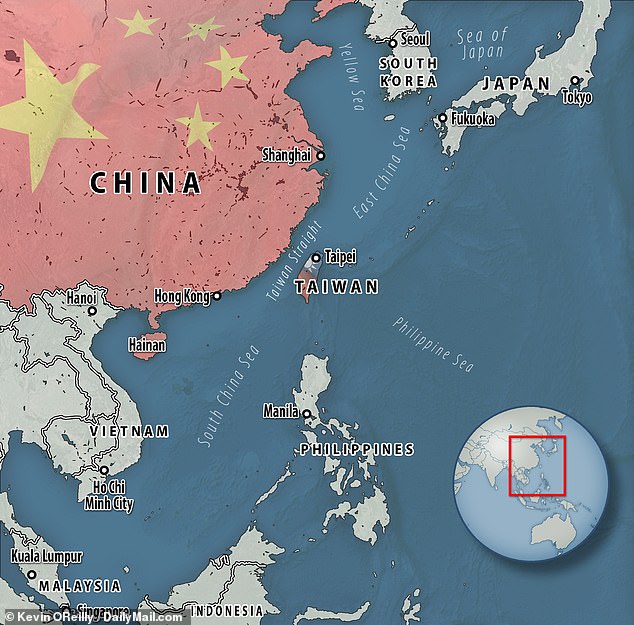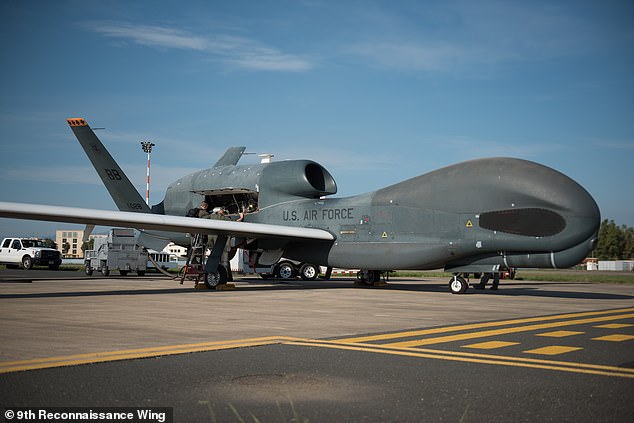Retired army general’s chilling warning over China’s chokehold on US military: ‘We need to prepare for war’
China’s stranglehold on US military supplies has left the West at the mercy of Beijing in the event of all-out war, a former army general has warned.
In an exclusive interview with DailyMail.com, retired US Army Major General John G. Ferrari said he had “serious concerns” about America’s continued dependence on China to equip its military.
Chinese manufacturers are deeply entrenched in U.S. defense systems, supplying crucial technology and raw materials used in everything from air-to-air missiles to fighter jets.
General Ferrari, who served as deputy commander for NATO in Afghanistan, admitted that Beijing could cripple America’s ability to arm itself by cutting off supply lines.
“If we were at war with China and the country stopped supplying parts, we wouldn’t be able to build the planes and weapons we needed,” he said.
In 2022, the Pentagon suspended deliveries of its flagship F-35 fighter jets after it was discovered they contained a part made with a banned Chinese alloy.

In 2012, the Senate Armed Services Committee found that counterfeit parts from China were being integrated into the US Army’s Stryker Mobile Gun (photo above)

Retired U.S. Army Major General John G. Ferrari told DailyMail.com he had “serious concerns” about the U.S. military’s continued dependence on China to equip its military.
His stark warning comes amid growing fears of a military confrontation with China over Taiwan.
The former general, now a senior fellow at the American Enterprise Institute, added: “We need to start preparing our supply chains now for a possible war.”
No quick fix
A surprising report released earlier this year found that Chinese companies are in control of 12 critical technologies vital to U.S. national security, including nuclear modernization, hypersonic technologies and space technologies.
The study, which was conducted at the request of the Pentagon by data analysis company Govini, provided a damning indictment of the US arms industry.
“U.S. domestic manufacturing capacity is a shriveled shadow of its former self,” the report said.
‘Crucial industrial categories for US national defense are no longer built in any of the fifty states.’
Perhaps most troubling, Govini found that more than 40 percent of the semiconductors supporting the Department of Defense (DoD) weapons systems now come from China.
Advanced semiconductors are crucial components of missile guidance systems, cyberware and artificial intelligence (AI).
It has fueled fears that Beijing has a range of tools to sabotage US defenses, from planting defective chips in air-to-air missiles to embedding spyware in DoD systems.
However, Ferrari warned that there is no quick fix.

In anticipation of a possible Chinese invasion of Taiwan, the US military conducts ominous war games in the Philippines (pictured during a joint exercise with the Philippine military on May 6, 2024)


Chinese President Xi Jinping has made no secret of his desire to reunify Taiwan with mainland China, but has left his rivals in the dark about when he might launch a surprise attack.
‘You can’t just turn around on a dime, because the [manufacturing] capacity doesn’t exist here,” he said.
He added that it could take 10 to 15 years for the US to break away from China.
But the former general, who was also a strategic planner for a Combined Joint Task Force in Iraq, hit out at Washington for being slow to respond.
“We are in our third administration trying to solve this problem. The Obama administration sounded the alarm, but they didn’t know what to do about it.
“The Trump administration has cracked down on the problem with tariffs and trade restrictions.
“Then Biden came in and built on that. We now have something of a bipartisan consensus.
‘But we’re still not pushing enough. With both Trump and Biden you hear ‘America First’. I don’t believe that is a good solution.
“It should be ‘Buy Allies’ because the US doesn’t have the capacity to solve the problem alone.”
The Biden administration has been criticized for its sclerotic response to the crisis, with experts citing a corny “non-binding preliminary memorandum of conditions (PMT)” to provide $162 million in federal funding to support the onshoring of semiconductor technology, which is a evidence of a lack of urgency in this matter.
General Ferrari has also said that the recently passed National Defense Authorization Act of 2024 has “little impact” on the timeline for eliminating the Pentagon’s dependence on China.
Driven by profit
The Department of Defense has long known that U.S. supply chains are dominated by Chinese manufacturing.
In 2012, the Senate Armed Services Committee found that counterfeit parts from China were being integrated into several critical systems, endangering national security.
These include AI capabilities in the Air Force’s Global Hawk unmanned surveillance aircraft, the Navy’s Integrated Submarine Imaging System, and the Army’s Stryker Mobile Gun.
Ten years later, the Pentagon suspended deliveries of its flagship F-35 fighter jets after it was discovered that they contained a part made with a banned Chinese alloy.
The Air Force eventually resumed deliveries after determining the parts would not affect security, but the scare underscored concerns about how the complexity of the military supply chain could allow defective parts or spyware to slip in unnoticed by Beijing.

Counterfeit parts from China were also found in the AI capabilities of the US Air Force’s Global Hawk unmanned surveillance aircraft (pictured above)
The US built its dependence on Chinese manufacturing during an era of relative harmony between the two countries after the 1990s.
American contractors were encouraged to do business with China, which could offer cheap manufacturing and easy access to raw materials.
But defense officials have become increasingly concerned about integrating supply chains in the wake of increased tensions with Beijing.
Yet the Defense Department’s dependence on Chinese equipment has continued to grow. According to Govini, US dependence on Chinese electronics increased by 600 percent between 2014 and 2022.
Courtney Manning, a senior researcher at the nonpartisan American Security Project, said the trend is “driven by profit.”
“US defense contractors have won extremely lucrative contracts that are difficult to get out of,” she told DailyMail.com.
‘They get a lot of freedom of choice and who they can work with. For many of them, sourcing their parts from China or Taiwan is a lucrative way to meet their high-tech needs without spending a fortune on manpower here in the US.”
No alternatives
But contractors have pointed to a lack of domestic options as U.S. manufacturing is in permanent decline.
Jeff Ferry, chief economist at the nonprofit Coalition for a Prosperous America, said drone manufacturers were desperately but largely unsuccessfully seeking American components.
“There may be a few hundred parts going into a drone,” he told DailyMail.com. ‘The majority of these are made in large volumes in China.’
Drones run on lithium, a mineral that China has a monopoly on.
Semiconductors require materials including gallium, arsenic and neon, much of which is produced in Russia, China and Ukraine.
The US does not produce gallium and the Russian invasion of Ukraine halved the world’s supply of semiconductor-grade neon.
The war in Ukraine has exposed widespread problems in the US arms industry.
US weapons stockpiles have fallen to dangerously low levels after Ukraine sent billions of dollars in military equipment and supplies.
But defense companies are not equipped to replenish them quickly.
A study by think tank the Center for Strategic and International Studies shows that the conflict in Eastern Europe has highlighted how quickly the US military would run out of ammunition in a potential conflict with China in the Indo-Pacific.
